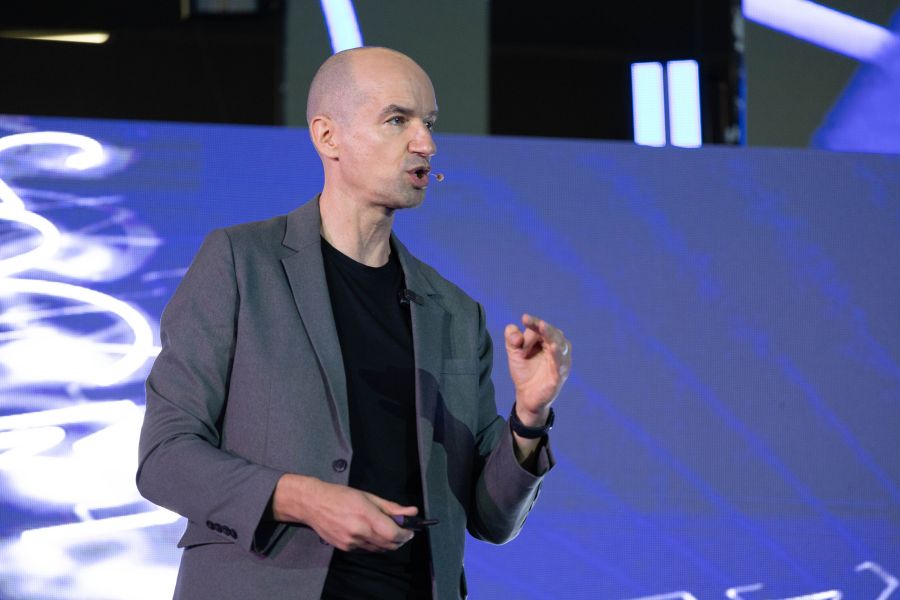Pascal Finette, Co-Founder of “be radical” and former Chair for Entrepreneurship and Open Innovation at Singularity University, shared tips on how to incorporate open innovation into organizations.
Speaking at the incMTY Summit, Finette highlighted how uncertainty about the future can actually be the basis for innovative thinking that uses technological advances as strengths.
“The future is not yet written, but in terms of technology, the future has already happened and we’re just catching up. Technology’s exponential growth curve is gradual and then sudden,” explained the panelist.
The speaker stressed the importance of not being surprised by disruption and shared advice on adopting an open innovation mindset to transform the reality of both the present and the future.

How to adopt an open innovation mindset?
Faced with the paradigm of exponential technological evolution and the task of innovating over time, Finette identified some tips that could be vital for structural transformation thinking.
1. Preparation, the first step towards innovation
While the panelist accepted that there’s no way to “predict” the future and what will or won’t be successful, Finette said it’s essential to have an understanding of the current panorama and how it might evolve.
“We have to understand that this world is advancing extremely quickly and that means preparing for what could happen tomorrow with the aim of acting today,” the entrepreneur urged.
Finette therefore invited his audience to keep a close eye on global trends, identifying skills, procedures, and technologies that could be rendered obsolete, as well as basic elements and functions that won’t change.
2. In order to have good ideas, you have to have a lot of ideas
Based on the words of American academic and inventor Linus Pauling, the speaker emphasized that the best way to have “good ideas” is to have “lots” of ideas, explaining how innovation innumerably lies in number.
“Most innovation efforts in businesses suffer from a lack of variety and number of initiatives, meaning that we don’t have enough ideas and those we have aren’t different enough,” he said.
Given this problem, Finette recommended not closing yourself off to innovation efforts (either your own or those of others), since even though they won’t all result in successful ideas, there’s a greater probability that one of them will be.
3. Consider that everything has more than one function
Embracing Clayton Christensen’s disruptive innovation theory, Finette recalled that people often buy products with the aim of creating progress in specific circumstances.
“People don’t buy drills because they want to have a drill. They want it for a project at home, to build something new. Basic needs don’t change, but the ways of meeting those needs do,” he shared.
Taking all this into consideration, the speaker said that innovation doesn’t necessarily have to come from a “new” product but can arise from things that already exist with the idea that they fulfill a different function.

4. Disruptive innovation requires a certain order
Faced with the goal of innovating and operating in a changing world, the co-founder of “be radical” presented the idea of working in symbiosis with the elements of structured order and the adaptability of chaos.
“There are elements to be rescued from order, such as structure, stability, and predictability, which can be complemented by elements of chaos, such as flexibility, adaptability, and innovation,” he stressed.
Given this, the panelist introduces the idea of innovation with “chaord” (a combination of chaos and order), highlighting that the important part of the process is to know where you’re going and not just the plan to get there.
5. Innovation can’t be an individual or vertical process
Finally, the panelist emphasized creating and/or belonging to an open innovation ecosystem that encourages a greater quantity and variety of ideas, while avoiding a nodal authority that encourages the creative process.
“In this open innovation ecosystem, everyone can learn from everyone, so there’s no need for a bottleneck to disrupt this system,” he said.
In order to create this system of controlled, “chaotic” innovation, Finette suggests first defining and agreeing on shared basic principles that will keep everyone moving in the same direction
.

The key to innovating in the future doesn’t lie in change
Finette acknowledged that the future is marked by the undeniable potential of technological advances, with the arrival of changes and turning points in the panorama being perceived as apparent “threats” to innovation.
However, the entrepreneur clarified that, in addition to how these kinds of moments of apparently “sudden” evolution have already occurred in the last decade, changes only refer to that which remains the same.
Finette explained that the core functions of the vast majority of disruptive innovations don’t change over long periods of time, providing an element of certainty even within the “chaos”.
“When we think about disruptive ideas of our time like the iPhone or Netflix, we realize at the end of the day that the core functions haven’t changed, because we’re still talking about a phone and a movie rental service,” he explained.
“When innovating, we must ask ourselves what doesn’t change instead of what does, since disruption is a state of change, which doesn’t necessarily have to be linear,” he said.
That being the case, the speaker emphasized first and foremost that open innovation involves an understanding of the future as well as preparation for it, without over-focusing on current “disruptive” ideas.
“The key to staying ahead of disruption is to not be surprised by it,” he said.
incMTY Summit 2024
The first edition of incMTY Summit was held on November 13 and 14, organized by incMTY from Tec de Monterrey, together with the Autonomous University of Nuevo León (UANL) and the Ministry of Economy of Nuevo León.
“This business, innovation, and investment summit provides a unique space where disruptive ideas spring to life through panels and networking activities, connecting to create impactful solutions for our society,” said Juan Pablo Murra, Rector of the Tec, during the event.
The central topics of this first edition included Open Innovation, Artificial Intelligence, Economic Development, Talent of the Future, Investment in Mexico, and Female Leadership.
The incMTY Summit had two venues: the first day at the Borregos Arena on the Tec’s Monterrey campus, and the second at the University Theater on the UANL’s Mederos campus.
LEE TAMBIÉN:





